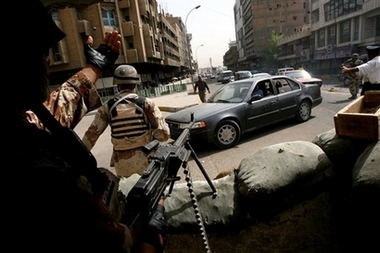US, Iraqi troops control only a third of Baghdad
(Reuters)Updated: 2007-06-05 09:14
BAGHDAD - US-led soldiers control only about a third of Baghdad, the military said on Monday, almost four months into a security crackdown during which troops are dying at rates not seen for more than two years.
 Iraqi soldiers and traffic police officers stop a car at a check point in Baghdad, Iraq, on Sunday, June 3, 2007. [AP]  |
The last of five brigades to be deployed in the crackdown will be in place soon, military spokesman Lieutenant-Christopher Garver said, adding it would not be possible to judge the success of the crackdown until all units were in place.
"Obviously we're constantly doing an assessment of the plan, but that plan doesn't kick in until everyone's here," he said.
But with violence spiking across Iraq as Sunni Islamist al Qaeda and insurgents try to derail the crackdown, US President George W. Bush and military leaders have warned that a bloody summer lies ahead.
"It's going to get harder before it gets easier," Garver said of the counter-insurgency effort.
"We know it's going to be a tough fight over the summer."
The New York Times reported earlier on Monday that, according to an internal military assessment and local commanders, US and Iraqi troops controlled 146 of Baghdad's 457 neighborhoods.
The New York Times said that, according to the one-page military assessment of the crackdown, troops had either not begun operations or still faced resistance in the capital's remaining 311 neighborhoods.
"Snapshot"
"That's kind of like a snapshot, those numbers are going to change the more you're working through those neighborhoods," Garver told Reuters, adding he had not seen the military assessment.
Bush won a bruising battle with a Congress for war funding but is under growing pressure, including from within his own Republican Party, to show progress in the unpopular war or start bringing troops home.
The crackdown in Baghdad and other areas is meant to buy time for Prime Minister Nuri al-Maliki's government to meet a set of political targets set by Washington aimed at promoting national reconciliation.
The benchmarks, which include a crucial revenue-sharing oil law and constitutional reform, are meant to draw minority Sunni Arabs, dominant under Saddam Hussein, away from the insurgency and back into the political process alongside majority Shi'ites.
June is showing similar casualty rates to May, with 17 US soldiers killed in the first three days, 14 of them reported on Sunday.
May was the third-worst month for US soldiers since the invasion to topple Saddam in March 2003. The worst months were November 2004, when 137 were killed, and April the same year when another 135 died.
Garver said more casualties were anticipated during the crackdown because thousands more troops were moving out of bases into command outposts, known as joint security stations, leaving them more exposed to attack.
"There is a short-term risk and that is what we've anticipated would happen in bringing about long-term benefit," Garver said.
Tens of thousands of Iraqis have been killed in the same period. While there was a significant reduction in the number of targeted sectarian killings early on in the security crackdown, those numbers have risen again, with dozens of bodies being found in Baghdad almost every day.
|
||
|
||
|
|